The Infantry
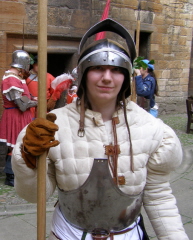
The mainstay of the Scottish in the centuries prior to 1526 was the infantrymen usually armed with a spear and very little else. The infamous 'schiltrons' of spear armed infantry raised by Wallace and Bruce were retained throughout the 15th Century with very little success. One exception was the Scottish army that ventured into France in support of the Dauphin during the Hundred Years War. These spearmen were accompanied by a notable contingent of bowman taken from the border forests and hills. Their initial success against the English led to one French advisor to declare that these men were 'the antidote to the English'. The Armee D'Ecosse's, despite a series of defeats in battle, went on to be invaluable allies and their leaders were ultimately rewarded with lands and titles in France.
The Scottish army that went across the border in 1513 was not only the biggest ever to leave the kingdom but also armed with the latest military hardware and trained in the latest tactics. As such it was primarily an infantry army; even the King chose to dismount to fight on foot amongst the front ranks. In accordance to the latest theories of war the 16th Century Scottish army was now made up of a number of 'wards' or 'battles' of anything up to 4,000 men strong, armed pimarily with the Pike*. Once on the move these 'human steamrollers' were to crush and any opposition by weight of numbers and momentum.
By the time of Pinkie in 1547, little had changed in the make up of the Scottish host. However they were no longer in touch with the latest thinking. Now armies needed to face a new threat - artillery. Armies required a balance of pike, shot and cavalry. An over reliance on one would inevitably lead to defeat. The resulting carnage amongst the Scottish pike blocks along the Esk was testement to this.
This section looks in detail at the infantry units deployed by the Scottish army in the early 16th Century and considers the likelihood of their presence and role on the battlefield at Linlithgow.
*The only difference between a spear and a pike is its length - and even then historians will interchange the name. Generally a spear is under 10ft and is sometimes referred to as a half pike.
Pike
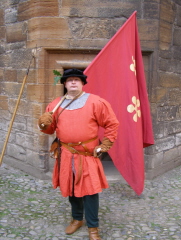 The Scottish host that stepped off down the slopes of Flodden Edge in 1513 were a part of the best equipped army ever to set foot out of Scotland. They were so well appointed in harness and so well covered by a veritable forest of pike that the arrows caused them little harm, bouncing off the plate armour, embedding themselves in the pavises or rattling down between the shafts of the pike. When the Scots finally came into contact with the English, it took up to five or six bill blows to bring them down.
The Scottish host that stepped off down the slopes of Flodden Edge in 1513 were a part of the best equipped army ever to set foot out of Scotland. They were so well appointed in harness and so well covered by a veritable forest of pike that the arrows caused them little harm, bouncing off the plate armour, embedding themselves in the pavises or rattling down between the shafts of the pike. When the Scots finally came into contact with the English, it took up to five or six bill blows to bring them down.
The majority of these infantry were armed with the pike. This was basically a 16 – 18ft ash stave with a steel pike head of about 10” to 12” long. The top section of the shaft was protected with strips of steel riveted onto the shaft called 'langets' which prevented the pike head being hewn off. The pike was notoriously difficult to carry so they were transported on the back of specially elongated wagons. However in combat they were notoriously difficult to handle and it was common for soldiers to cut off the bottom few feet to make the weapon lighter.
Suitable staves of ash had virtually run out by the middle of the 16th century in Scotland so there was a roaring import trade from the Netherlands . In 1513 spies informed Henry VIII that boat loads of pike were being shipped from Camphere in Zeeland. Likewise, 3000 pikes of white ash and 500 of Spanish ash along with 500 halberds appeared in the Treasurer’s Accounts in 1541. The pikeheads were a little easier to source as they were churned out by local cutlers and blacksmiths.
As an individual weapon the pike is all but useless. Any attack can be easily paried and the attacker can work his way 'past the point'. Then the pike becomes an encumbance and has to be discarded. The pikeman is then forced to resort to his personal side arms often a sword and buckler. However en masse the pike block can present up to 6 ranks of weapons pointing at various attitudes towards the attacker. Should the man manage to pass the first point he will find himself enveloped in a hedge of staves with more points heading his way. Patten aptly described the pikeman in action at Pinkie:
In their array towards the joining with the enemy, they cling and thrust so near in the fore rank, shoulder to shoulder together with their pikes in both hands straight afore them; and their followers in that order so hard at their backs, laying their pikes over their foregoers shoulders that they do assail undissevered, no force can withstand them’.
‘Standing at the defence, they thrust their shoulders likewise so nigh together; the fore rank so well nigh to kneeling, stoop low before their fellows behind holding their pikes in both hands and therewith on their left arms their bucklers, the one end of the pike against their right foot, the other against the enemy breast high, their followers crossing their pike points with them forward; and thus each with the other so nigh as place and space will suffer, through the whole Ward so thick that easily should a bare finger pierce through the skin of an angry hedgehog, as any encounter the front of their pikes.’
The Scots at Flodden were said to have advanced in the 'manner of the Almaynes' - that is to say emulating the German Landschneckts and Swiss who were dominant on the battlefields of mainland Europe. They advanced in blocks of some 2,000 men or more often 20 deep, in pace and without a word (in order to ensure orders by voice, trumpet and drum could be heard). The wards advanced in echelon with the left battle stepping off first. This allowed the commanders of the centre wards the opportunity to change the point of attack should the left ward fail to charge home or to take advantage of their unexpected success.
In order for pikeblocks to be successful they required to keep their shape and momentum. Should they stop or become disordered either by terrain or a breakdown of moral or discipline, then they were prone to the effects of shot and other attack of other pike blocks. The Scots at Flodden were disrupted by a burn at the bottom of Branxton Hill and those at Pinkie were stopped by the suicidal charge by the English heavy cavalry.
Bow
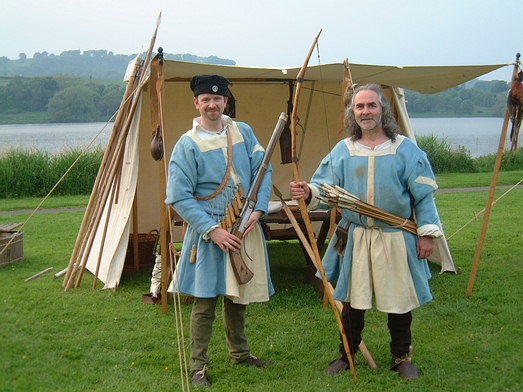 Unlike the 'Auld Enemy', the Scots did not embrace the use of the bow during the medieval period as did the English. However this is not to say that they had no bowmen. Many of the troops that went to France with the Armee D'Ecosse during the Hundred Years War were armed with the bow and were recruited from the Borders. Border horsemen also had little respect for boundaries when it came to arming themselves, being happy to carry both a long bow and crossbow amongst their arsenal.
Unlike the 'Auld Enemy', the Scots did not embrace the use of the bow during the medieval period as did the English. However this is not to say that they had no bowmen. Many of the troops that went to France with the Armee D'Ecosse during the Hundred Years War were armed with the bow and were recruited from the Borders. Border horsemen also had little respect for boundaries when it came to arming themselves, being happy to carry both a long bow and crossbow amongst their arsenal.
In the Highlands, clansmen continued to use the bow for hunting. There is some debate as to whether they used recurve bows favoured in Ireland or the traditional longbow. There is evidence for both and probably both were used. Certainly the highland contingents at both Flodden and Pinkie provided the main contingents of bowmen but they had little influence on the outcome of either engagement.
Troops afforded the protection of pavises or parapets found themselves with time and cover and favoured the use of the crossbow. This was easier to master than the longbow and cheaper. However the slow rate of fire meant the operator could be prone to attack on an open battlefield. Naturally the Border Reivers carried lighter versions of the crossbow called a latch which could be fired from horseback and easily reloaded.
It is interesting to note that Flodden was the last 'bill bow battle fought by the English. The weather and the quality of the Scottish armour proved too much for the English longbowmen to be effective. The shafts were seen to bounce off the Scottish armour and rattle down between the forest of pike.
Shot
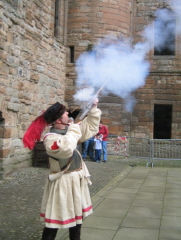 By the beginning of the 16th century there was a viable replacement for the crossbow in Europe. The development of metallurgy and gunpowder had given rise to the hackbut or harquebus. Guns had been around for much of the previous century but they were often more dangerous to the operator than to the target. By 1526 continental armies were equipping a greater proportion of their missile men with guns. At Pavia in 1525 the French forces were soundly defeated by an Imperialist army and the French cavalry were brought to a halt by the deployment of landsknechts harquebusiers. The mighty Swiss suffered a similar fate at Bicocca in 1522, when faced by German gunners protected by a ditch and wall.
By the beginning of the 16th century there was a viable replacement for the crossbow in Europe. The development of metallurgy and gunpowder had given rise to the hackbut or harquebus. Guns had been around for much of the previous century but they were often more dangerous to the operator than to the target. By 1526 continental armies were equipping a greater proportion of their missile men with guns. At Pavia in 1525 the French forces were soundly defeated by an Imperialist army and the French cavalry were brought to a halt by the deployment of landsknechts harquebusiers. The mighty Swiss suffered a similar fate at Bicocca in 1522, when faced by German gunners protected by a ditch and wall.
We have William Patten to thank for the misconception that the Scots had failed to embrace this new weapon to any extent by the time of Pinkie. His comment that there were few gunners on the Scottish side has been widely quoted as evidence for the Scots reluctance to employ new technology. But perhaps Patten passed comment because this was exceptional rather than the normal state of affairs. Albany's army that marched on Wark in 1523 was well equipped with guns and we know the French landed many guns at Dumbarton prior to the Flodden campaign although they failed to get them to the battlefield in any great numbers.
Suffice to say that the gun was a viable weapon in 1526 and we can expect both sides to be equipped with a fair smattering of firearms on the day. They may not have accounted for many casualties but they would have certainly added to the noise and smoke on the field.
Polearms
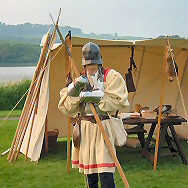 Polearms is the generic title given to any weapon that is hafted onto a stave. They come in all shapes and sizes and often hail from agricultural or domestic usage.
Polearms is the generic title given to any weapon that is hafted onto a stave. They come in all shapes and sizes and often hail from agricultural or domestic usage.
The simplest polearm is the spear or half pike. These weapons were 6ft to 10 ft in length and fitted with a steel point. Strips of metal rivoted onto the stave, called Langets, would protect the top third of the shaft from decapitation and in some cases lugs or 'boar stoppers' are fitted below the point to ensure the spear does go too far into the victim and can therefore be easily extracted.
Spears however can only be used as a thrusting weapon. Other polearms combine a number of blades and points to enable the attacker to launch a number of attacks. Polearms such as the Bill and harlberd combine a scything attack, with a puncturing blow with a spike. The spike can be combined with a hook designed to entangle the opponents belt, straps and armour in order to pull him off balance.
The English used the bill to good effect at Flodden but even when they doubled up on the unfortunate Scottish laird it would take up to 14 blows to finish him off. Those less well armoured would expect to receive a crippling wound from just one heavy blow.
Other polearms include war hammers and maces. Peculiar to Scottish armouries was the Broggit staff, a spiked iron sphere set upon a 5ft stave, sometimes called a 'Holy water sprinkler' by the English.
Another colloquial weapon was the Jedart Stave, a border weapon consisting of a thin double edged blade that protrudes from a shaft by some few feet. The hands were protected by round plates or rondels mounted around the shaft which not only protected the knuckles but also added to the weapons thrusting power.
As Polearms were cheap and easy to store, they were often the weapon of choice within a household and therefore were regularly taken along to the muster. Although many of the owners would have been asked to swap these for a pike for the campaign a small group would be retained as protection for the standard bearers and to act as a mobile reserve sent into the enemy flanks to disrupt the ranks with their devastating scything blows.

